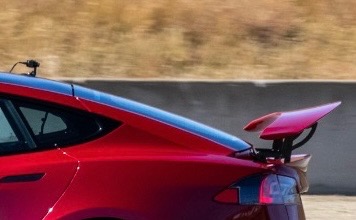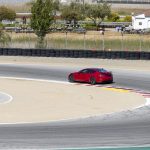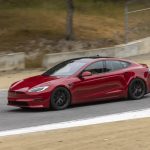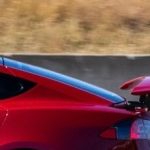

News
Tesla Model S Plaid hits Laguna Seca with giant rear wing in run-up to first deliveries
Tesla is preparing for Model S Plaid deliveries as it is beginning the final testing phases of the Tri-Motor, all-electric performance sedan that has been in development for several years.
After rumors surfaced of a record-setting Model S Plaid at the Auto Club Famoso Raceway, The Kilowatts ventured to Laguna Seca Raceway, where Tesla was also spotted testing several Model S variants. Upon the sighting of two Model S vehicles at the track, one red and one black, it became apparent that Tesla was testing the two cars ahead of initial deliveries.
BREAKING: Tesla is CURRENTLY attempting lap records in a couple of Model S Plaid (possibly a Plaid+) prototypes at Laguna Seca Raceway!
They just secured a 1:30:XX (unconfirmed time)
This is a developing story – more photos and videos to follow. pic.twitter.com/BqxPdK4k43— The Kilowatts 🚗⚡️ (@klwtts) May 14, 2021
In fact, one Model S appeared to have a retractable, adjustable spoiler, a device that seemed to be similar to the spoiler on early Model X builds. On early Model X vehicles, Tesla included a retractable, electric, active spoiler that the driver could control from the vehicle’s cockpit. Tesla eventually did away with this in 2017 and chose to go with a stationary spoiler instead.
- Tesla Model S Plaid track testing at Laguna Seca Raceway (May 14 2021, Credit: The Kilowatts)
- Tesla Model S Plaid rear wing spotted track testing at Laguna Seca Raceway (May 14 2021, Credit: The Kilowatts)
- Tesla Model S Plaid track testing at Laguna Seca Raceway (May 14 2021, Credit: The Kilowatts)
- Tesla Model S Plaid track testing at Laguna Seca Raceway (May 14 2021, Credit: The Kilowatts)
Credit: The Kilowatts
Interestingly, Tesla did utilize a spoiler on the Model S Plaid before. It occurred in late 2019 when the Model S Plaid hit the Nürburgring in Germany. While the variant of the Plaid Powertrain-fitted Model S was sporting a rear-spoiler in that instance, CEO Elon Musk confirmed to Teslarati that it would not be permanent and it was only going to be placed on the car temporarily for “rear downforce calibration.” Musk confirmed that the wing would not be utilized or crucial to impeccable performance, and it also wouldn’t be included in the production version of the vehicle.
The big rear wing is only on for one day for rear downforce calibration. Isn’t needed to set ring record & won’t be in the production car.
— Elon Musk (@elonmusk) October 23, 2019
The Model S Plaid is no stranger to the Laguna Seca course, either. In September 2019, Tesla also set the Laguna Seca record for the fastest four-door vehicle ever with the Model S Plaid. With a record of 1:36.555, the Model S Plaid dethroned its sibling Model 3 Performance with a time of 1:37.5 and the all-time record set by a Jaguar XE SV Project 8 with a time of 1:37.54.
Deliveries of the new Model S vehicle builds could occur in the coming weeks. After a message to a Model S Plaid reservation holders indicated that an update to the anticipated delivery timelines should be coming within the next week. “Due to high volume of Model S orders Tesla has at this time, we currently don’t have an estimated delivery date for you but that should change within the next week, as soon as there is an estimated delivery date provided internally for you order, I will reach out ASAP,” the message said.
Tesla originally slated initial deliveries of the Plaid Model S for February, but Musk also told Teslarati that the car was still undergoing minor refinements and that there’s “nothing else even close.” It appears that what was running at Laguna Seca could definitely be the Plaid Model S variant that will make its way to customers very soon.

News
Tesla FSD fleet is nearing 7 billion total miles, including 2.5 billion city miles
As can be seen on Tesla’s official FSD webpage, vehicles equipped with the system have now navigated over 6.99 billion miles.

Tesla’s Full Self-Driving (Supervised) fleet is closing in on almost 7 billion total miles driven, as per data posted by the company on its official FSD webpage.
These figures hint at the massive scale of data fueling Tesla’s rapid FSD improvements, which have been quite notable as of late.
FSD mileage milestones
As can be seen on Tesla’s official FSD webpage, vehicles equipped with the system have now navigated over 6.99 billion miles. Tesla owner and avid FSD tester Whole Mars Catalog also shared a screenshot indicating that from the nearly 7 billion miles traveled by the FSD fleet, more than 2.5 billion miles were driven inside cities.
City miles are particularly valuable for complex urban scenarios like unprotected turns, pedestrian interactions, and traffic lights. This is also the difference-maker for FSD, as only complex solutions, such as Waymo’s self-driving taxis, operate similarly on inner-city streets. And even then, incidents such as the San Francisco blackouts have proven challenging for sensor-rich vehicles like Waymos.
Tesla’s data edge
Tesla has a number of advantages in the autonomous vehicle sector, one of which is the size of its fleet and the number of vehicles training FSD on real-world roads. Tesla’s nearly 7 billion FSD miles then allow the company to roll out updates that make its vehicles behave like they are being driven by experienced drivers, even if they are operating on their own.
So notable are Tesla’s improvements to FSD that NVIDIA Director of Robotics Jim Fan, after experiencing FSD v14, noted that the system is the first AI that passes what he described as a “Physical Turing Test.”
“Despite knowing exactly how robot learning works, I still find it magical watching the steering wheel turn by itself. First it feels surreal, next it becomes routine. Then, like the smartphone, taking it away actively hurts. This is how humanity gets rewired and glued to god-like technologies,” Fan wrote in a post on X.
News
Tesla starts showing how FSD will change lives in Europe
Local officials tested the system on narrow country roads and were impressed by FSD’s smooth, human-like driving, with some calling the service a game-changer for everyday life in areas that are far from urban centers.

Tesla has launched Europe’s first public shuttle service using Full Self-Driving (Supervised) in the rural Eifelkreis Bitburg-Prüm region of Germany, demonstrating how the technology can restore independence and mobility for people who struggle with limited transport options.
Local officials tested the system on narrow country roads and were impressed by FSD’s smooth, human-like driving, with some calling the service a game-changer for everyday life in areas that are far from urban centers.
Officials see real impact on rural residents
Arzfeld Mayor Johannes Kuhl and District Administrator Andreas Kruppert personally tested the Tesla shuttle service. This allowed them to see just how well FSD navigated winding lanes and rural roads confidently. Kruppert said, “Autonomous driving sounds like science fiction to many, but we simply see here that it works totally well in rural regions too.” Kuhl, for his part, also noted that FSD “feels like a very experienced driver.”
The pilot complements the area’s “Citizen Bus” program, which provides on-demand rides for elderly residents who can no longer drive themselves. Tesla Europe shared a video of a demonstration of the service, highlighting how FSD gives people their freedom back, even in places where public transport is not as prevalent.
What the Ministry for Economic Affairs and Transport says
Rhineland-Palatinate’s Minister Daniela Schmitt supported the project, praising the collaboration that made this “first of its kind in Europe” possible. As per the ministry, the rural rollout for the service shows FSD’s potential beyond major cities, and it delivers tangible benefits like grocery runs, doctor visits, and social connections for isolated residents.
“Reliable and flexible mobility is especially vital in rural areas. With the launch of a shuttle service using self-driving vehicles (FSD supervised) by Tesla in the Eifelkreis Bitburg-Prüm, an innovative pilot project is now getting underway that complements local community bus services. It is the first project of its kind in Europe.
“The result is a real gain for rural mobility: greater accessibility, more flexibility and tangible benefits for everyday life. A strong signal for innovation, cooperation and future-oriented mobility beyond urban centers,” the ministry wrote in a LinkedIn post.
News
Tesla China quietly posts Robotaxi-related job listing
Tesla China is currently seeking a Low Voltage Electrical Engineer to work on circuit board design for the company’s autonomous vehicles.

Tesla has posted a new job listing in Shanghai explicitly tied to its Robotaxi program, fueling speculation that the company is preparing to launch its dedicated autonomous ride-hailing service in China.
As noted in the listing, Tesla China is currently seeking a Low Voltage Electrical Engineer to work on circuit board design for the company’s autonomous vehicles.
Robotaxi-specific role
The listing, which was shared on social media platform X by industry watcher @tslaming, suggested that Tesla China is looking to fill the role urgently. The job listing itself specifically mentions that the person hired for the role will be working on the Low Voltage Hardware team, which would design the circuit boards that would serve as the nervous system of the Robotaxi.
Key tasks for the role, as indicated in the job listing, include collaboration with PCB layout, firmware, mechanical, program management, and validation teams, among other responsibilities. The role is based in Shanghai.
China Robotaxi launch
China represents a massive potential market for robotaxis, with its dense urban centers and supportive policies in select cities. Tesla has limited permission to roll out FSD in the country, though despite this, its vehicles have been hailed as among the best in the market when it comes to autonomous features. So far, at least, it appears that China supports Tesla’s FSD and Robotaxi rollout.
This was hinted at in November, when Tesla brought the Cybercab to the 8th China International Import Expo (CIIE) in Shanghai, marking the first time that the autonomous two-seater was brought to the Asia-Pacific region. The vehicle, despite not having a release date in China, received a significant amount of interest among the event’s attendees.













